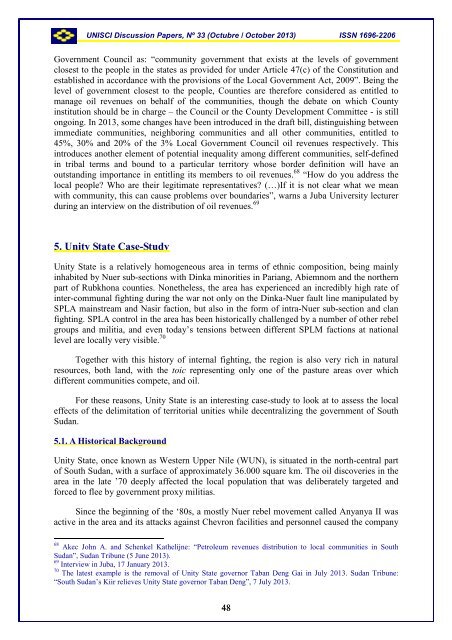UNISCI - Universidad Complutense de Madrid
UNISCI - Universidad Complutense de Madrid
UNISCI - Universidad Complutense de Madrid
You also want an ePaper? Increase the reach of your titles
YUMPU automatically turns print PDFs into web optimized ePapers that Google loves.
<strong>UNISCI</strong> Discussion Papers, Nº 33 (Octubre / October 2013) ISSN 1696-2206Government Council as: “community government that exists at the levels of governmentclosest to the people in the states as provi<strong>de</strong>d for un<strong>de</strong>r Article 47(c) of the Constitution an<strong>de</strong>stablished in accordance with the provisions of the Local Government Act, 2009”. Being thelevel of government closest to the people, Counties are therefore consi<strong>de</strong>red as entitled tomanage oil revenues on behalf of the communities, though the <strong>de</strong>bate on which Countyinstitution should be in charge – the Council or the County Development Committee - is stillongoing. In 2013, some changes have been introduced in the draft bill, distinguishing betweenimmediate communities, neighboring communities and all other communities, entitled to45%, 30% and 20% of the 3% Local Government Council oil revenues respectively. Thisintroduces another element of potential inequality among different communities, self-<strong>de</strong>finedin tribal terms and bound to a particular territory whose bor<strong>de</strong>r <strong>de</strong>finition will have anoutstanding importance in entitling its members to oil revenues. 68 “How do you address thelocal people? Who are their legitimate representatives? (…)If it is not clear what we meanwith community, this can cause problems over boundaries”, warns a Juba University lecturerduring an interview on the distribution of oil revenues. 695. Unity State Case-StudyUnity State is a relatively homogeneous area in terms of ethnic composition, being mainlyinhabited by Nuer sub-sections with Dinka minorities in Pariang, Abiemnom and the northernpart of Rubkhona counties. Nonetheless, the area has experienced an incredibly high rate ofinter-communal fighting during the war not only on the Dinka-Nuer fault line manipulated bySPLA mainstream and Nasir faction, but also in the form of intra-Nuer sub-section and clanfighting. SPLA control in the area has been historically challenged by a number of other rebelgroups and militia, and even today’s tensions between different SPLM factions at nationallevel are locally very visible. 70Together with this history of internal fighting, the region is also very rich in naturalresources, both land, with the toic representing only one of the pasture areas over whichdifferent communities compete, and oil.For these reasons, Unity State is an interesting case-study to look at to assess the localeffects of the <strong>de</strong>limitation of territorial unities while <strong>de</strong>centralizing the government of SouthSudan.5.1. A Historical BackgroundUnity State, once known as Western Upper Nile (WUN), is situated in the north-central partof South Sudan, with a surface of approximately 36.000 square km. The oil discoveries in thearea in the late ’70 <strong>de</strong>eply affected the local population that was <strong>de</strong>liberately targeted andforced to flee by government proxy militias.Since the beginning of the ‘80s, a mostly Nuer rebel movement called Anyanya II wasactive in the area and its attacks against Chevron facilities and personnel caused the company68 Akec John A. and Schenkel Kathelijne: “Petroleum revenues distribution to local communities in SouthSudan”, Sudan Tribune (5 June 2013).69 Interview in Juba, 17 January 2013.70 The latest example is the removal of Unity State governor Taban Deng Gai in July 2013. Sudan Tribune:“South Sudan’s Kiir relieves Unity State governor Taban Deng”, 7 July 2013.48
















